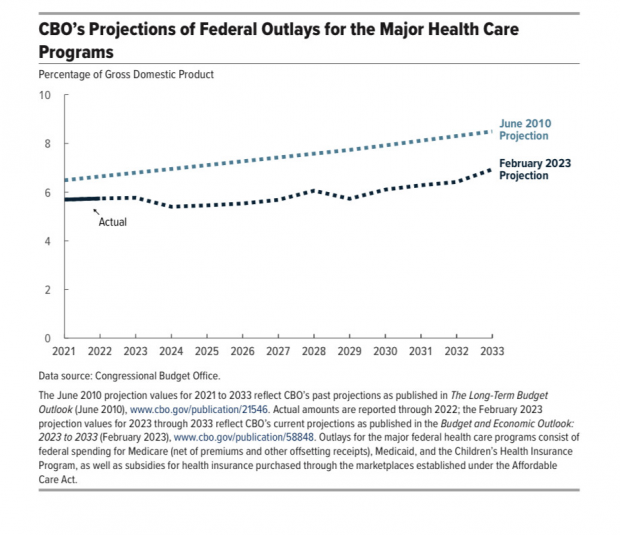The Congressional Budget Office says the projections it made soon after the passage of the Affordable Care Act overestimated the level of federal mandatory spending on health care for the period 2010 to 2020, and such spending is expected to continue to come in below the agency’s 2010 projections for years to come (see the chart below).
Responding to an inquiry from Sen. Sheldon Whitehouse (D-RI), CBO director Phillip Swagel said Friday that federal spending on programs including Medicare and Medicaid was 9% lower – or roughly $1.1 trillion – from 2010 to 2020 than projected in 2010. The lower-than-expected spending overall was largely the result of lower costs per beneficiary, Swagel said, driven in part by less spending on prescription drugs in Medicare and on long-term services and supports in Medicaid than originally estimated.
The growth rate for health care spending is slowing, Swagel added, citing a long-running trend. “The rate of growth in federal mandatory spending on health care per beneficiary has slowed sharply since 2005,” he wrote. “For example, Medicare spending per beneficiary grew at an average annual rate of 6.6 percent between 1987 and 2005, 3.1 percent between 2007 and 2012, and 2.2 percent between 2013 and 2019.”
As for why the spending in key areas was lower than expected, CBO analysts were unable to fully account for the results, but Swagel cited two factors that contributed to the trend: reduced spending on patients with cardiovascular disease and “decreases in the growth of Medicare’s payment rates, which are set through laws and regulations.”
Although Swagel provided no further detail, he cited his appearance before a Senate committee in 2020, where he explained that “[s]lower growth of Medicare payment rates has been a major factor contributing to the slowdown in the growth of Medicare spending in various ways. The ACA permanently reduced the annual payment updates in the Medicare fee-for-service (FFS) program for hospitals and other institutional providers by the projected growth in economywide productivity. … Those decreases in the growth of payment rates directly slowed the growth of Medicare spending by reducing the amount paid for each service.”
Still, although health care spending has been lower than projected in 2010, the U.S. continues to spend far more than its peers. “The United States spends a larger share of its gross domestic product (GDP) on health care than other advanced economies and performs worse on various measures of health outcomes than many of those same countries,” Swagel said. “In 2019, U.S. health expenditures were 17.6 percent of GDP, nearly 7 percentage points higher than the average of other comparably wealthy countries.”
The bottom line: Whatever the cause, slower growth in health care spending could help extend the lives of the Medicare trust funds and is good news for both federal and state government budgets.





